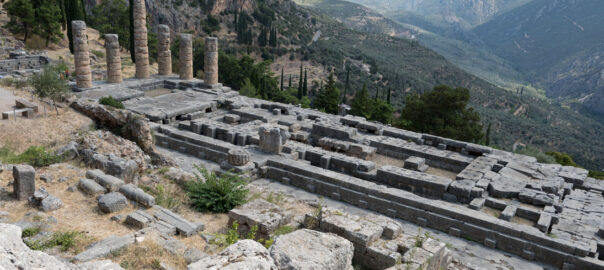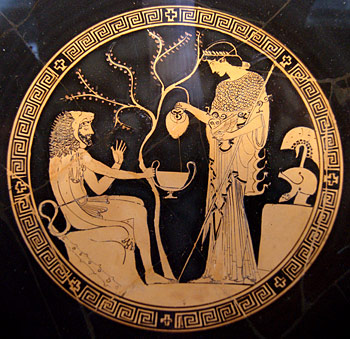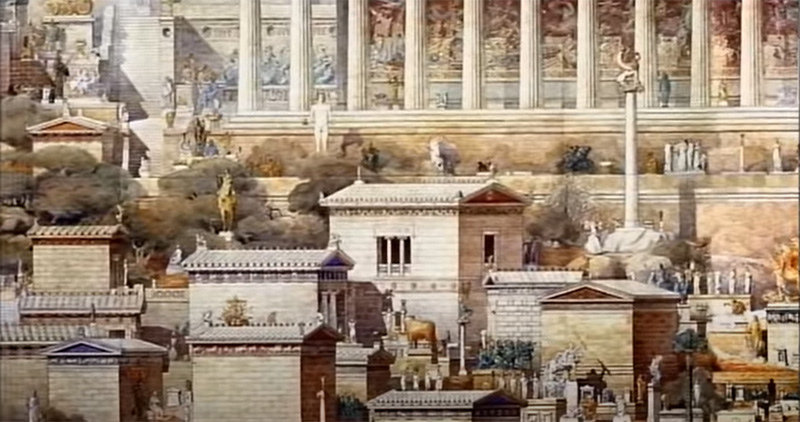
Archaic Greece:
Religious Life
Temple of Apollo, Delphi, Zde, Wikimedia Commons
Like other pre-Axial cultures, Greeks believed in a pantheon of gods who presided over every aspect of life and nature.
As in other cultures, the development of Greek religion focused around those aspects of Greek life that were of primary importance, for the Greeks it was the resolution of conflict or statis, the development of community, and individual excellence. Greek mythological stories are about conflict, yet, as we have seen in Homer’s epic, veneration of their mythical heroes bound the Greeks together around a glorious past. Greek religion was part of the attempt to reinforce a common sense of purpose, civic cohesion, and community.

Religion and politics were inextricable aspects of Greek life; adherence to traditional rites and to the civic and social expectations of the city-state demonstrated that one belonged. Like other pre-Axial cultures, Greeks believed in a pantheon of gods who presided over every aspect of life and nature and if one wanted their help, they required sacrifice. This was especially true on the political level: no political authority could be exercised absent the appropriate ritual sacrifices. Sacrifices were the central event around which festivals, athletics, oracles, and all other events honoring the gods were focused. A sacrificial ceremony was a communal affair, not only were all of the members of the community there, eating together and bonding socially, the Greeks believed that the gods participated directly as well.
When the Indo-European peoples arrived on the Greek islands from the north, their pantheon of gods was headed by the sky god variously known as Zeus (Greek), Dyaus (Indian), or Jupiter (Roman). The inhabitants also appear to have had a sky god who became identified as Zeus as well. The name Dionysus (also called Bacchus) occurs in the Linear B tablets of the 13th century BCE, so it seems very likely that his worship was a part of Mycenaean religion. Dionysus had the power to inspire and to create ecstasy, and his cult had special importance for art and literature.
The major deities of the Greek pantheon were Zeus, Poseidon, Hera, Demeter, Aphrodite, Athena, Artemis, Apollo, Ares, Hephaestus, Hermes, and either Hestia or Dionysus. They were given a home on Mount Olympus. Once established there in a conspicuous position, the Olympians came to be identified with local deities and to be assigned as consorts to the local gods and goddess.
Cult mysteries provided experiences of a more personal nature, even though these were never enacted in solitude. For example, the Eleusinian mystery cult which had initiatory rituals that Greeks experienced as transformative; the mystery cult of Dionysus too, enabled worshippers to experience divine possession, and the knowledge that the god was truly among them.
“The origin of the mystery ceremonies does seem to be India: or, at least, the place and time when the Brahman priesthood started its initiation. The ceremonies were based upon the Hindu myths but the procedure followed in training by the aspirant is strikingly similar in Egypt. And Egypt profoundly influenced Greece.” says Arkon Daraul in Secret Societies.
Where the God Speaks…

Oracles were the way in which the people of ancient Greece could communicate with their gods. Since direct communication with a deity was impossible, the person that the gods spoke though—often a woman—formed a bridge between the divine realm and the world of mortals. The temples at Klaros ond Delphi are examples of sacred oracle sites that the Greeks believed gave them access to the god Apollo. They were both built around places where rock fissures released spring water containing a magical power in the form of gases called pneuma (“breath” or “spirit”).
Only Apollo’s prophet was permitted to enter this spot and stand in the god’s presence, near the omphalos (“navel” stone) that represented him. Breathing the gases and drinking the sacred water, the medium reached an altered state of consciousness that allowed Apollo to take over and, through her, to speak.


Michael Scott of Cambridge University uncovers the secrets of the most famous oracle in the ancient world. A vital force in ancient history, it was a gateway into the supernatural, and at its heart was the famous inscription which still inspires visitors today—‘Know Thyself.’
During the time when the oracle was in operation, pneuma were not only released into the space above, but were also in the water and travertine rock. Plutarch, who was once a priest at Delphi, tells us that the priestess would sit on a tripod over the cleft. Breathing in the gases—now thought to be intoxicating light hydrocarbon gases such as methane, ethane and ethylene—she would fall into a trance that enabled Apollo to speak through her. She would mutter incomprehensible words that would be interpreted by the priests for those who had submitted their questions. Professor Hale of the University of Louisville notes that although the religious conviction and fervor may have been sincere, sites such as Delphi were created, and rituals “stage-managed,” to produce an illusion of where one was and what was happening:
“The temple is set on a high stone podium a long way above the rock where the fissure is. When you go in the door you go down a deep ramp into what the ancients describe as ‘a cave’ created by the temple rising around you. You feel as if you are at the heart of mother earth, which seems to be at the heart of so many religious experiences.”
Dating from the Greek Mycenaean period (from the 14th to the 11th centuries BCE), the Oracle of Delphi became the most important shrine in Greece and survived until Christianity supervened, around the fourth century CE. As we will see, the Greeks of the Axial Age continued to believe in multiple gods, adapting legends, myths and rituals in creative ways in an effort to reduce conflict and support democratic participation.
External Stories and Videos


Watch: Secrets Of The Aegean Apocalypse
Watch: Secrets Of The Aegean Apocalypse
Around 1,200 BC, an ancient Armageddon destroyed nearly every known civilization. What could have caused it? The theories are many, but most now include one mysterious and massively destructive factor – a force only the Egyptians survived to name: The Sea People.
